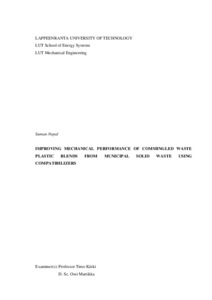Improving mechanical performance of commingled waste plastic blends from municipal solid waste using compatibilizers
Nepal, Suman (2018)
Diplomityö
Nepal, Suman
2018
School of Energy Systems, Konetekniikka
Kaikki oikeudet pidätetään.
Julkaisun pysyvä osoite on
https://urn.fi/URN:NBN:fi-fe2018120749963
https://urn.fi/URN:NBN:fi-fe2018120749963
Tiivistelmä
The plastic waste is considered as one of the dangerous waste for the environment because the plastics are non-biodegradable and emits harmful gaseous on burning so, the recycling is the best option for management of waste plastics. The plastic waste contains different plastic types and recycling them individually is costly. The easier way to recycle is by mixing plastics together to make polymer blend and recycling the blend. Due to immiscibility of plastics, the polymer blend possess degraded properties as compared to individual waste plastic properties. The compatibilizer is used for improving properties of polymer blend.
This thesis work studies the effect of compatibilizing on polymer blends made with the recycled plastics from Municipal Solid Waste (MSW). The composition amount of types of plastic waste used in preparing polymer blends are similar to their composition amount on total sorted plastic waste. The plastic wastes were sorted, cleaned, granulated, and injection molded for manufacturing of test pieces. The plastics waste were sorted with Near Infrared Spectroscopy which identified 52 % of total plastic waste remaining were unidentified. The test material groups or blends prepared for experimental work are S1 (all plastics), S2 (unidentified plastics), S3 (S1 + 3 % compatibilizer), and S4 (S2 + 3 % compatibilizer).
The Compatibilization process has resulted in an increase on melt flow and tensile properties. The scanning electron microscope (SEM) and Energy dispersive spectroscopy (EDS) showed that the material groups or blends possess a high amount of impurities and foreign elements however, no RoHS restricted harmful elements were found on the polymer blends. The 3% of compatibilizer have worked well on polymer blends and have improved the properties but with the proper cleaning of waste plastics the properties can be improved further with the same amount of compatibilizer.
This thesis work studies the effect of compatibilizing on polymer blends made with the recycled plastics from Municipal Solid Waste (MSW). The composition amount of types of plastic waste used in preparing polymer blends are similar to their composition amount on total sorted plastic waste. The plastic wastes were sorted, cleaned, granulated, and injection molded for manufacturing of test pieces. The plastics waste were sorted with Near Infrared Spectroscopy which identified 52 % of total plastic waste remaining were unidentified. The test material groups or blends prepared for experimental work are S1 (all plastics), S2 (unidentified plastics), S3 (S1 + 3 % compatibilizer), and S4 (S2 + 3 % compatibilizer).
The Compatibilization process has resulted in an increase on melt flow and tensile properties. The scanning electron microscope (SEM) and Energy dispersive spectroscopy (EDS) showed that the material groups or blends possess a high amount of impurities and foreign elements however, no RoHS restricted harmful elements were found on the polymer blends. The 3% of compatibilizer have worked well on polymer blends and have improved the properties but with the proper cleaning of waste plastics the properties can be improved further with the same amount of compatibilizer.
